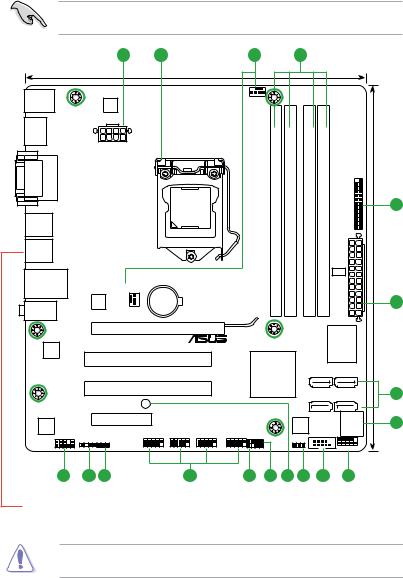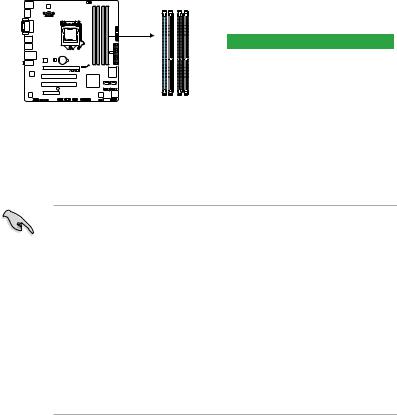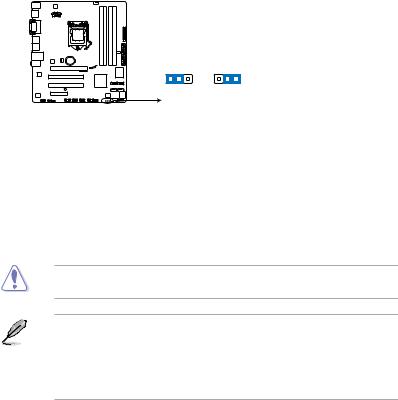ASUS P8Q67-M DO USB3 TPM, P8Q67-M DO User Manual

P8Q67-M DO/TPM P8Q67-M DO/USB3/TPM
Motherboard

E6500
First Edition (V1)
March 2011
Copyright © 2011 ASUSTeK Computer Inc. All Rights Reserved.
No part of this manual, including the products and software described in it, may be reproduced, transmitted, transcribed, stored in a retrieval system, or translated into any language in any form or by any means, except documentation kept by the purchaser for backup purposes, without the express written permission of ASUSTeK Computer Inc. (“ASUS”).
Product warranty or service will not be extended if: (1) the product is repaired, modified or altered, unless such repair, modification of alteration is authorized in writing byASUS; or (2) the serial number of the product is defaced or missing.
ASUS PROVIDES THIS MANUAL “AS IS” WITHOUT WARRANTY OF ANY KIND, EITHER EXPRESS OR IMPLIED, INCLUDING BUT NOT LIMITED TO THE IMPLIED WARRANTIES OR CONDITIONS OF MERCHANTABILITY OR FITNESS FOR A PARTICULAR PURPOSE. IN NO EVENT SHALL ASUS, ITS DIRECTORS, OFFICERS, EMPLOYEES OR AGENTS BE LIABLE FOR ANY INDIRECT, SPECIAL, INCIDENTAL, OR CONSEQUENTIAL DAMAGES (INCLUDING DAMAGES FOR LOSS OF PROFITS, LOSS OF BUSINESS, LOSS OF USE OR DATA, INTERRUPTION OF BUSINESS AND THE LIKE), EVEN IF ASUS HAS BEEN ADVISED OF THE POSSIBILITY OF SUCH DAMAGES ARISING FROM ANY DEFECT OR ERROR IN THIS MANUAL OR PRODUCT.
SPECIFICATIONS AND INFORMATION CONTAINED IN THIS MANUAL ARE FURNISHED FOR INFORMATIONAL USE ONLY, AND ARE SUBJECT TO CHANGE AT ANY TIME WITHOUT NOTICE, AND SHOULD NOT BE CONSTRUED AS A COMMITMENT BY ASUS. ASUS ASSUMES NO RESPONSIBILITY OR LIABILITY FOR ANY ERRORS OR INACCURACIES THAT MAY APPEAR IN THIS MANUAL, INCLUDING THE PRODUCTS AND SOFTWARE DESCRIBED IN IT.
Products and corporate names appearing in this manual may or may not be registered trademarks or copyrights of their respective companies, and are used only for identification or explanation and to the owners’ benefit, without intent to infringe.
Offer to Provide Source Code of Certain Software
This product may contain copyrighted software that is licensed under the General Public License (“GPL”) and under the Lesser General Public License Version (“LGPL”). The GPL and LGPL licensed code in this product is distributed without any warranty. Copies of these licenses are included in this product.
You may obtain the complete corresponding source code (as defined in the GPL) for the GPL Software, and/or the complete corresponding source code of the LGPL Software (with the complete machinereadable “work that uses the Library”) for a period of three years after our last shipment of the product including the GPL Software and/or LGPL Software, which will be no earlier than December 1, 2011, either
(1)for free by downloading it from http://support.asus.com/download;
or
(2)for the cost of reproduction and shipment, which is dependent on the preferred carrier and the location where you want to have it shipped to, by sending a request to:
ASUSTeK Computer Inc.
Legal Compliance Dept.
15 Li Te Rd.,
Beitou, Taipei 112
Taiwan
In your request please provide the name, model number and version, as stated in the About Box of the product for which you wish to obtain the corresponding source code and your contact details so that we can coordinate the terms and cost of shipment with you.
The source code will be distributed WITHOUT ANY WARRANTY and licensed under the same license as the corresponding binary/object code.
This offer is valid to anyone in receipt of this information.
ASUSTeK is eager to duly provide complete source code as required under various Free Open Source Software licenses. If however you encounter any problems in obtaining the full corresponding source code we would be much obliged if you give us a notification to the email address gpl@asus.com, stating the product and describing the problem (please do NOT send large attachments such as source code archives etc to this email address).
ii

Contents
Notices......................................................................................................... |
vi |
Safety information...................................................................................... |
vii |
About this guide........................................................................................ |
viii |
P8Q67-M DO Series specifications summary........................................... |
ix |
Chapter 1: Product introduction
1.1 |
Before you proceed...................................................................... |
1-1 |
|
1.2 |
Motherboard overview................................................................. |
1-2 |
|
|
1.2.1 |
Motherboard layout .......................................................... |
1-2 |
|
1.2.2 |
Layout contents . .............................................................. |
1-3 |
1.3 |
Central Processing Unit (CPU).................................................... |
1-3 |
|
1.4 |
System memory............................................................................ |
1-4 |
|
|
1.4.1 |
Overview .......................................................................... |
1-4 |
|
1.4.2 |
Memory configurations . ................................................... |
1-4 |
1.5 |
Expansion slots............................................................................ |
1-8 |
|
|
1.5.1 |
Installing an expansion card ............................................ |
1-8 |
|
1.5.2 |
Configuring an expansion card ........................................ |
1-8 |
|
1.5.3 |
PCI slot ............................................................................ |
1-8 |
|
1.5.4 |
PCI Express x4 slot . ........................................................ |
1-8 |
|
1.5.5 |
PCI Express x16 slot . ...................................................... |
1-8 |
1.6 |
Jumpers |
......................................................................................... |
1-9 |
1.7 |
Connectors.................................................................................. |
1-10 |
|
|
1.7.1 .................................................. |
Rear panel connectors |
1-10 |
|
1.7.2 ........................................................ |
Internal connectors |
1-12 |
1.8 |
Software ........................................................................support |
1-19 |
|
|
1.8.1 ....................................... |
Installing an operating system |
1-19 |
|
1.8.2 ............................................... |
Support DVD information |
1-19 |
Chapter 2: BIOS information
2.1 |
Managing and updating your BIOS............................................. |
2-1 |
|
|
2.1.1 |
ASUS Update utility......................................................... |
2-1 |
|
2.1.2 ASUS EZ Flash 2............................................................ |
2-2 |
|
|
2.1.3 ASUS CrashFree BIOS 3 utility....................................... |
2-3 |
|
|
2.1.4 |
ASUS BIOS Updater....................................................... |
2-4 |
2.2 |
BIOS setup program..................................................................... |
2-7 |
|
iii

Contents
2.3 |
Main menu................................................................................... |
2-10 |
|
|
2.3.1 |
System Language [English]............................................ |
2-11 |
|
2.3.2 |
System Date [Day xx/xx/xxxx]........................................ |
2-11 |
|
2.3.3 |
System Time [xx:xx:xx]................................................... |
2-11 |
|
2.3.4 |
Security........................................................................... |
2-11 |
2.4 |
Ai Tweaker menu........................................................................ |
2-12 |
|
|
2.4.1 |
Memory Frequency [Auto]............................................. |
2-13 |
|
2.4.2 |
iGPU Max. Frequency [Auto]......................................... |
2-13 |
|
2.4.3 |
EPU Power Saving Mode [Disabled]............................. |
2-13 |
|
2.4.4 |
GPU Boost [OK]............................................................ |
2-13 |
|
2.4.5 |
DRAM Timing Control.................................................... |
2-13 |
|
2.4.6 |
CPU Power Management.............................................. |
2-13 |
|
2.4.7 |
Offset Mode Sign [+]...................................................... |
2-14 |
|
2.4.8 |
iGPU Offset Mode Sign [+]............................................ |
2-15 |
|
2.4.9 |
DRAM Voltage [Auto]..................................................... |
2-15 |
|
2.4.10 |
VCCIO Voltage [Auto].................................................... |
2-15 |
|
2.4.11 |
PCH Voltage [Auto]........................................................ |
2-15 |
|
2.4.12 |
Load-Line Calibration [Auto].......................................... |
2-15 |
2.5 |
Advanced menu.......................................................................... |
2-16 |
|
|
2.5.1 |
Trusted Computing........................................................ |
2-16 |
|
2.5.2 |
CPU Configuration......................................................... |
2-16 |
|
2.5.3 |
SystemAgent Configuration.......................................... |
2-18 |
|
2.5.4 |
PCH Configuration......................................................... |
2-18 |
|
2.5.5 |
SATAConfiguration........................................................ |
2-18 |
|
2.5.6 |
Intel TXT(LT) Configuration........................................... |
2-19 |
|
2.5.7 |
USB Configuration......................................................... |
2-20 |
|
2.5.8 |
ME Subsystem.............................................................. |
2-20 |
|
2.5.9 |
AMT Configuration......................................................... |
2-20 |
|
2.5.10 |
Onboard Devices Configuration.................................... |
2-21 |
|
2.5.11 |
APM............................................................................... |
2-22 |
|
2.5.12 |
Serial Port Console Redirection.................................... |
2-23 |
2.6 |
Monitor menu.............................................................................. |
2-24 |
|
|
2.6.1 |
CPU Temperature / MB Temperature [xxxºC/xxxºF]...... |
2-25 |
|
2.6.2 |
CPU / Chassis Fan Speed............................................. |
2-25 |
|
2.6.3 |
CPU Q-Fan Control [Enabled]....................................... |
2-25 |
iv

Contents
|
2.6.4 |
Chassis Q-Fan Control [Enabled].................................. |
2-26 |
|
2.6.5 |
CPU Voltage, 3.3V Voltage, 5V Voltage, 12V Voltage... |
2-26 |
|
2.6.6 |
Anti Surge Support [Enabled]........................................ |
2-26 |
2.7 |
Boot menu................................................................................... |
2-27 |
|
|
2.7.1 |
Bootup NumLock State [On].......................................... |
2-27 |
|
2.7.2 |
Full Screen Logo [Enabled]........................................... |
2-27 |
|
2.7.3 |
Option ROM Messages [Force BIOS]........................... |
2-27 |
|
2.7.4 |
Setup Mode [EZ Mode].................................................. |
2-28 |
|
2.7.5 |
Boot Option Priorities..................................................... |
2-28 |
|
2.7.6 |
Boot Override................................................................ |
2-28 |
2.8 |
Tools menu.................................................................................. |
2-29 |
|
|
2.8.1 |
ASUS EZ Flash Utility.................................................... |
2-29 |
|
2.8.2 |
ASUS SPD Information................................................. |
2-29 |
|
2.8.3 |
ASUS O.C. Profile......................................................... |
2-29 |
2.9 |
Exit menu..................................................................................... |
2-30 |
|

Notices
Federal Communications Commission Statement
This device complies with Part 15 of the FCC Rules. Operation is subject to the following two conditions:
•This device may not cause harmful interference, and
•This device must accept any interference received including interference that may cause undesired operation.
This equipment has been tested and found to comply with the limits for a Class B digital device, pursuant to Part 15 of the FCC Rules. These limits are designed to provide reasonable protection against harmful interference in a residential installation. This equipment generates, uses and can radiate radio frequency energy and, if not installed and used in accordance with manufacturer’s instructions, may cause harmful interference to radio communications. However, there is no guarantee that interference will not occur in a particular installation. If this equipment does cause harmful interference to radio or
television reception, which can be determined by turning the equipment off and on, the user is encouraged to try to correct the interference by one or more of the following measures:
•Reorient or relocate the receiving antenna.
•Increase the separation between the equipment and receiver.
•Connect the equipment to an outlet on a circuit different from that to which the receiver is connected.
•Consult the dealer or an experienced radio/TV technician for help.
The use of shielded cables for connection of the monitor to the graphics card is required to assure compliance with FCC regulations. Changes or modifications to this unit not expressly approved by the party responsible for compliance could void the user’s authority to operate this equipment.
Canadian Department of Communications Statement
This digital apparatus does not exceed the Class B limits for radio noise emissions from digital apparatus set out in the Radio Interference Regulations of the Canadian Department of Communications.
This class B digital apparatus complies with Canadian ICES-003.
ASUS Recycling/Takeback Services
ASUS recycling and takeback programs come from our commitment to the highest standards for protecting our environment. We believe in providing solutions for you to be able to responsibly recycle our products, batteries, other components as well as the packaging materials. Please go to http://csr.asus.com/english/Takeback.htm for the detailed recycling information in different regions.
vi

REACH
Complying with the REACH (Registration, Evaluation, Authorisation, and Restriction of Chemicals) regulatory framework, we published the chemical substances in our products at ASUS REACH website at http://csr.asus.com/english/REACH.htm.
DO NOT throw the motherboard in municipal waste. This product has been designed to enable proper reuse of parts and recycling. This symbol of the crossed out wheeled bin indicates that the product (electrical and electronic equipment) should not be placed in municipal waste. Check local regulations for disposal of electronic products.
DO NOT throw the mercury-containing button cell battery in municipal waste. This symbol of the crossed out wheeled bin indicates that the battery should not be placed in municipal waste.
Safety information
Electrical safety
•To prevent electric shock hazard, disconnect the power cable from the electric outlet before relocating the system.
•When adding or removing devices to or from the system, ensure that the power cables for the devices are unplugged before the signal cables are connected. If possible, disconnect all power cables from the existing system before you add a device.
•Before connecting or removing signal cables from the motherboard, ensure that all power cables are unplugged.
•Seek professional assistance before using an adapter or extension cord. These devices could interrupt the grounding circuit.
•Ensure that your power supply is set to the correct voltage in your area. If you are not sure about the voltage of the electrical outlet you are using, contact your local power company.
•If the power supply is broken, do not try to fix it by yourself. Contact a qualified service technician or your retailer.
Operation safety
•Before installing the motherboard and adding devices on it, carefully read all the manuals that came with the package.
•Before using the product, ensure that all cables are correctly connected and the power cables are not damaged. If you detect any damage, contact your dealer immediately.
•To avoid short circuits, keep paper clips, screws, and staples away from connectors, slots, sockets and circuitry.
•Avoid dust, humidity, and temperature extremes. Do not place the product in any area where it may become wet.
•Place the product on a stable surface.
•If you encounter technical problems with the product, contact a qualified service technician or your retailer.
vii

About this guide
This user guide contains the information you need when installing and configuring the motherboard.
How this guide is organized
This guide contains the following parts:
•Chapter 1: Product introduction
This chapter describes the features of the motherboard and the new technology it supports.
•Chapter 2: BIOS information
This chapter tells how to change system settings through the BIOS Setup menus. Detailed descriptions of the BIOS parameters are also provided.
Conventions used in this guide
To ensure that you perform certain tasks properly, take note of the following symbols used throughout this manual.
DANGER/WARNING: Information to prevent injury to yourself when trying to complete a task.
CAUTION: Information to prevent damage to the components when trying to complete a task.
IMPORTANT: Instructions that you MUST follow to complete a task.
NOTE: Tips and additional information to help you complete a task.
Where to find more information
Refer to the following sources for additional information and for product and software updates.
1.ASUS websites
The ASUS website provides updated information on ASUS hardware and software products. Refer to the ASUS contact information.
2.Optional documentation
Your product package may include optional documentation, such as warranty flyers, that may have been added by your dealer. These documents are not part of the standard package.
Typography
Bold text |
Indicates a menu or an item to select. |
Italics |
Used to emphasize a word or a phrase. |
<Key> |
Keys enclosed in the less-than and greater-than sign means |
|
that you must press the enclosed key. |
|
Example: <Enter> means that you must press the Enter or |
|
Return key. |
<Key1>+<Key2>+<Key3> |
If you must press two or more keys simultaneously, the key |
|
names are linked with a plus sign (+). |
|
Example: <Ctrl>+<Alt>+<D> |
viii

P8Q67-M DO Series specifications summary
CPU |
LGA1155 socket for Intel® Second Generation Core™ i7 / Core™ i5 / |
||
|
|
Core™ i3 processors |
|
Chipset |
* Refer to www.asus.com for Intel® CPU support list. |
||
Intel® Q67 Express Chipset |
|
||
Memory |
4 x DIMM, maximum 32GB*, DDR3 1333 / 1066 MHz, non-ECC, |
|
|
|
|
un-buffered memory |
|
|
Dual-channel memory architecture |
||
|
* |
The maximum 32GB memory capacity can be supported with |
|
|
|
8GB or above DIMMs. ASUS will update the memory QVL |
|
|
** |
once the DIMMs are available in the market. |
|
|
Refer to www.asus.com for the latest Memory QVL (Qualified |
||
|
|
Vendors List). |
|
|
*** When you install a total memory of 4GB capacity or more, Windows® |
||
|
|
32-bit operating system may only recognize less than 3GB. We |
|
|
|
recommend a maximum of 3GB system memory if you are using a |
|
Expansion slots |
|
Windows® 32-bit operating system. |
|
1 x PCI Express 2.0 x16 slot |
|
||
|
1 x PCI Express 2.0 x4 slot |
||
Graphics |
2 x PCI slots |
||
Supports D-Sub with max. resolution up to 2048 x 1536 x 32Bpp @75Hz |
|
||
|
Supports DVI with max. resolution up to 1920 x 1200 x 32Bpp @60Hz |
||
Storage |
Supports Display Port with max. resolution up to 2560 x 1600 @60HZ |
||
Intel® Q67 Express Chipset: |
|
||
|
|
- 2 x SerialATA6.0 Gb/s connectors (gray) |
|
|
|
- 4 x SerialATA3.0 Gb/s connectors (blue) |
|
|
|
- Intel® Matrix Storage technology supports RAID 0, 1, 0+1(10), 5 |
|
LAN |
|
configurations |
|
Intel® 82579 Gigabit LAN controller |
|
||
Audio |
VIA® VT1708S 8-channel* High DefinitionAudio CODEC |
|
|
|
|
- Supports Jack-Detection, Multi-streaming, and Anti-pop |
|
|
* |
function |
|
|
Use a chassis with HD audio module in the front panel to support an |
||
USB |
|
8-channel audio output. |
|
P8Q67-M DO/USB3/TPM: |
|
||
|
Intel® Q67 Express Chipset: |
||
|
|
- 12 x USB 2.0/1.1 ports (8 ports at the mid-board, 4 ports at the |
|
|
|
back panel) |
|
Asmedia USB3.0 controller:
- 2 x USB 3.0/2.0 ports (blue, at the back panel)
P8Q67-M DO/TPM:
- 14 x USB 2.0/1.1 ports (8 ports at the mid-board, 6 ports at the back panel)
(continued on the next page)
ix

P8Q67-M DO Series specifications summary
ASUS unique features
Back panel I/O ports
Internal connectors / buttons / switches
BIOS
Manageability
Accessories
Support DVD
Form factor
ASUS Q-Fan 2
ASUS CrashFree BIOS 3
ASUS EZ Flash 2
ASUS MyLogo 2™
ASUS Anti-Surge Protection
ASUS GPU Boost
ASUS EPU
1 x PS/2 Mouse port (green)
1 x PS/2 Keyboard port (purple)
1 x Display Port
1 x DVI-D port
1 x VGA port
1 x LAN (RJ-45) port
6 x USB 2.0/1.1 ports (P8Q67-M DO/TPM only)
4 x USB 2.0/1.1 ports; 2 x USB 3.0 ports (P8Q67-M DO/ USB3/TPM only)
3 x Audio jacks
4 x USB 2.0/1.1 connectors support additional 8 USB 2.0/1.1 ports
2 x SATA6.0Gb/s connectors
4 x SATA3.0Gb/s connectors
1 x CPU fan / 1 x Chassis fan connectors 1 x LPT connector
1 x Front panel audio connector
1 x COM connector
1 x S/PDIF output connector
1 x Speaker connector
1 x Chassis intrusion connector
1 x 24-pin EATX power connector
1 x 8-pin EATX 12V power connector
1 x System panel connector
1 x TPM IC onboard
64 Mb Flash ROM, EFIAMI BIOS, PnP, DMI 2.0, WfM 2.0, ACPI 2.0a, SM BIOS 2.6, Multi-language BIOS, ASUS CrashFree BIOS 3,ASUS EZ Flash 2
WfM 2.0, DMI 2.0, WOL by PME, WOR by PME, PXE
1 x SerialATA3.0Gb/s cable
1 x SerialATA6.0Gb/s cable
1 x I/O shield
1 x User Manual
1 x Support DVD
Drivers ASUS utilities ASUS Update
Anti-virus software (OEM version)
MicroATX form factor: 9.6 in x 8.9 in (24.4 cm x 22.6 cm)
* Specifications are subject to change without notice.

Chapter 1
Product introduction
Thank you for buying an ASUS® P8Q67-M DO Series motherboard!
Before you start installing the motherboard, and hardware devices on it, check the items in your motherboard package. Refer to page x for the list of accessories.
If any of the items is damaged or missing, contact your retailer.
ASUS P8Q67-M DO Series motherboards include P8Q67-M DO/TPM and P8Q67-M DO/USB3/TPM two models. The layout varies with models. The layout illustrations in this user guide are for P8Q67-M DO/USB3/TPM only.
1.1Before you proceed
Take note of the following precautions before you install motherboard components or change any motherboard settings.
• Unplug the power cord from the wall socket before touching any component.
•Before handling components, use a grounded wrist strap or touch a safely grounded object or a metal object, such as the power supply case, to avoid damaging them due to static electricity.
•Hold components by the edges to avoid touching the ICs on them.
•Whenever you uninstall any component, place it on a grounded antistatic pad or in the bag that came with the component.
•Before you install or remove any component, ensure that the ATX power supply is switched off or the power cord is detached from the power supply. Failure to do so may cause severe damage to the motherboard, peripherals, or components.
Onboard LED
The motherboard comes with a standby power LED that lights up to indicate that the system is ON, in sleep mode, or in soft-off mode. This is a reminder that you should shut down
the system and unplug the power cable before removing or plugging in any motherboard component. The illustration below shows the location of the onboard LED.
SB_PWR
P8Q67-M DO/USB3/TPM
ON OFF
Standby Power Powered Off
P8Q67-M DO/USB3/TPM Onboard LED
Chapter 1: Product introduction |
1-1 |

1.2Motherboard overview
1.2.1Motherboard layout
Ensure that you install the motherboard into the chassis in the correct orientation. The edge with external ports goes to the rear part of the chassis.
|
1 |
2 |
3 |
|
4 |
|
|
|
|
22.6cm(8.9in) |
|
|
|
|
|
KBMS |
EPU |
|
CPU_FAN |
|
|
|
|
|
|
|
|
|
|
|
|
DP |
|
|
|
|
|
|
|
|
EATX12V |
|
module)pin |
module)pin |
module)pin |
module)pin |
|
VGADVI |
|
|
LPT |
||||
|
|
|
240- |
240- |
240- |
240- |
|
|
|
LGA1155 |
(64bit, |
(64bit, |
(64bit, |
(64bit, |
|
|
|
|
|
||||
USB56 |
|
|
DIMM A1 |
DIMM A2 |
DIMM B1 |
DIMM B2 |
|
USB34 |
|
|
|
||||
|
|
DDR3 |
DDR3 |
DDR3 |
DDR3 |
|
|
|
|
|
|
||||
|
|
|
|
|
|
|
TPM IC |
LAN1_USB12 |
CHA_FAN |
|
|
|
|
|
|
|
|
|
|
|
EATXPWR |
||
|
Intel® |
Lithium Cell |
|
|
|
|
|
|
82579 |
CMOS Power |
|
|
|
|
|
AUDIO |
|
|
|
|
|
|
|
|
|
PCIEX16 |
|
|
|
|
|
|
P8Q67-M DO/USB3/TPM |
|
|
|
Super |
||
ASM |
|
|
|
I/O |
|||
1042 |
|
|
|
|
|
|
|
|
|
PCI1 |
|
|
|
|
|
|
|
|
Intel® |
|
SATA3G_2 |
SATA3G_1 |
|
|
|
|
Q67 |
|
|
|
|
|
|
PCI2 |
|
|
|
|
|
|
|
|
|
|
SATA3G_4 |
SATA3G3 |
|
|
SB_PWR |
|
|
|
|
|
|
|
PCIEX4_1 |
|
|
|
|
|
1 2 |
|
VIA |
|
|
|
64Mb |
|
SATA6G |
SATA6G |
|
|
|
|
|
|
||||
VT1708S |
|
|
|
|
BIOS |
|
||
|
USB1314 USB1112 |
USB910 |
USB78 |
SPEAKER |
|
COM1 |
||
|
|
|
|
|||||
|
SPDIF_OUT |
|
|
|
CLRTC |
|
|
|
AAFP |
DIS_ME |
|
|
CHASSIS |
|
|
F_PANEL |
|
17 |
16 |
15 |
14 |
13 |
12 |
11 |
10 |
9 |
8 |
5
24.4cm(9.6in)
1
6
7
•2 x USB 3.0 ports (blue) on P8Q67-M DO/USB3/TPM, OR:
•2 x USB 2.0/1.1 ports (black) on P8Q67-M DO/TPM
Place six screws into the holes indicated by circles to secure the motherboard to the chassis. DO NOT overtighten the screws! Doing so can damage the motherboard.
1-2 |
ASUS P8Q67-M DO Series |

1.2.2Layout contents
|
Connectors/Jumpers/Slots/LED |
Page |
Connectors/Jumpers/Slots/LED |
Page |
|
1. |
ATX power connectors (24-pin EATXPWR, |
|
10. |
Clear RTC RAM (3-pin CLRTC) |
|
|
8-pin EATX12V) |
|
|
|
|
2. |
Intel® LGA1155 CPU socket |
|
11. |
Standby power LED (SB_PWR) |
|
3. |
CPU and chassis fan connectors (4-pin |
|
12. |
Speaker connector (4-pin SPEAKER) |
|
|
CPU_FAN, 3-pin CHA_FAN) |
|
|
|
|
4. |
DDR3 DIMM slots |
|
13. |
Chassis intrusion connector (4-1 pin CHASSIS) |
|
5. |
LPT connector (26-1 pin LPT) |
|
14. |
USB connectors (10-1 pin USB78, USB910, |
|
|
|
|
|
USB1112, USB1314) |
|
6. |
Intel® Q67 SerialATA3.0Gb/s connectors |
|
15. |
Intel® ME jumper (3-pin DIS_ME) |
|
|
(7-pin SATA3G_1~4 [blue]) |
|
|
|
|
7. |
Intel® Q67 SerialATA6.0Gb/s connectors |
|
16. |
Digital audio connector (4-1 pin SPDIF_OUT) |
|
|
(7-pin SATA6G_1/2 [gray]) |
|
|
|
|
8. |
System panel connector (10-1 pin F_PANEL) |
|
17. |
Front panel audio connector (10-1 pinAAFP) |
|
9. |
Serial port connector (10-1 pin COM1) |
|
|
|
|
1.3Central Processing Unit (CPU)
The motherboard comes with a surface mount LGA1155 socket designed for the Intel® second generation Core™ i7 / Core™ i5 / Core™ i3 processors.
Unplug all power cables before installing the CPU.
• Upon purchase of the motherboard, ensure that the PnP cap is on the socket and the socket contacts are not bent. Contact your retailer immediately if the PnP cap is missing, or if you see any damage to the PnP cap/socket contacts/motherboard components. ASUS will shoulder the cost of repair only if the damage is shipment/transit-related.
•Keep the cap after installing the motherboard. ASUS will process Return Merchandise
Authorization (RMA) requests only if the motherboard comes with the cap on the
LGA1155 socket.
•The product warranty does not cover damage to the socket contacts resulting from incorrect CPU installation/removal, or misplacement/loss/incorrect removal of the PnP cap.
Chapter 1: Product introduction |
1-3 |

1.4System memory
1.4.1Overview
The motherboard comes with four Double Data Rate 3 (DDR3) Dual Inline Memory Modules (DIMM) sockets.
ADDR3 module has the same physical dimensions as a DDR2 DIMM but is notched differently to prevent installation on a DDR2 DIMM socket. DDR3 modules are developed for better performance with less power consumption.
The figure illustrates the location of the DDR3 DIMM sockets:
DIMM A1 |
DIMM A2 |
DIMM B1 |
DIMM B2 |
P8Q67-M DO/USB3/TPM |
|
|
|
Channel |
Sockets |
Channel A |
DIMM_A1 and DIMM_A2 |
Channel B |
DIMM_B1 and DIMM_B2 |
P8Q67-M DO/USB3/TPM 240-pin DDR3 DIMM sockets
1.4.2Memory configurations
You may install 512MB, 1GB, 2GB, 4GB, and 8GB unbuffered non ECC DDR3 DIMMs into the DIMM sockets.
•You may install varying memory sizes in ChannelAand Channel B. The system maps the total size of the lower-sized channel for the dual-channel configuration.Any excess memory from the higher-sized channel is then mapped for single-channel operation.
•Always install DIMMs with the same CAS latency. For optimum compatibility, we recommend that you obtain memory modules from the same vendor.
•The maximum 32GB memory capacity can be supported with 8GB or above DIMMs.
ASUS will update the memory QVL once the DIMMs are available in the market.
•Due to the memory address limitation on 32-bit Windows® OS, when you install 4GB or more memory on the motherboard, the actual usable memory for the OS can be about 3GB or less. For effective use of memory, we recommend that you do any of the following:
-Use a maximum of 3GB system memory if you are using a 32-bit Windows® OS.
-Install a 64-bit Windows® OS when you want to install 4GB or more on the motherboard.
•This motherboard does not support DIMMs made up of 512Mb (64MB) chips or less.
1-4 |
ASUS P8Q67-M DO Series |

• The default memory operation frequency is dependent on its Serial Presence Detect (SPD), which is the standard way of accessing information from a memory module. Under the default state, some memory modules for overclocking may operate at a lower frequency than the vendor-marked value. To operate at the vendor-marked or at a higher frequency, refer to section 2.4 Ai Tweaker menu for manual memory frequency adjustment.
•For system stability, use a more efficient memory cooling system to support a full memory load (4 DIMMs) or overclocking condition.
P8Q67-M DO Series Motherboard Qualified Vendors Lists (QVL)
DDR3-1333 MHz capability
Vendors |
Part No. |
Size |
SS/ |
Chip |
Chip NO. |
Timing |
Voltage |
DIMM socket |
|
|
support (Optional) |
||||||||||
|
|
|
DS |
Brand |
|
|
|
A* |
B* |
C* |
|
|
|
|
|
|
|
|
|||
A-Data |
AD31333001GOU |
1GB |
SS |
A-Data |
AD30908C8D-151C |
- |
- |
• |
• |
• |
E0906 |
||||||||||
A-Data |
AD31333G001GOU |
3GB(3 x 1GB) |
SS |
- |
- |
8-8-8-24 |
1.65-1.85V |
• |
• |
|
A-Data |
AD31333002GOU |
2GB |
DS |
A-Data |
AD30908C8D-151C |
- |
- |
• |
• |
• |
E0903 |
||||||||||
A-Data |
AD31333G002GMU |
2GB |
DS |
- |
- |
8-8-8-24 |
1.65-1.85V |
• |
• |
• |
Apacer |
78.A1GC6.9L1 |
2GB |
DS |
APACER |
AM5D5808DEWSBG |
- |
- |
• |
• |
• |
Apacer |
78.A1GC6.9L1 |
2GB |
DS |
Apacer |
AM5D5808FEQSBG |
9 |
- |
• |
• |
• |
CORSAIR |
CM3X1024-1333C9DHX |
1GB |
SS |
- |
- |
9-9-9-24 |
1.60V |
• |
• |
|
CORSAIR |
CM3X1024-1333C9 |
1GB |
SS |
- |
- |
9-9-9-24 |
1.60V |
• |
• |
• |
CORSAIR |
TR3X3G1333C9 G |
3GB(3 x 1GB) |
SS |
- |
- |
9-9-9-24 |
1.50V |
• |
• |
|
CORSAIR |
TR3X3G1333C9 G |
3GB(3 x 1GB) |
SS |
- |
- |
9-9-9-24 |
1.50V |
• |
• |
|
CORSAIR |
TR3X3G1333C9 |
3GB(3 x 1GB) |
SS |
- |
- |
9-9-9-24 |
1.50V |
• |
• |
• |
CORSAIR |
CMD24GX3M6A1333C9(XMP) |
24GB(6x4GB) |
DS |
- |
- |
9-9-9-24 |
1.60V |
• |
• |
• |
CORSAIR |
CM3X2048-1333C9DHX |
2GB |
DS |
- |
- |
- |
- |
• |
• |
|
CORSAIR |
TW3X4G1333C9 G |
4GB(2 x 2GB) |
DS |
- |
- |
9-9-9-24 |
1.50V |
• |
• |
• |
CORSAIR |
CMX8GX3M4A1333C9 |
8GB(4 x 2GB) |
DS |
- |
- |
9-9-9-24 |
1.50V |
• |
• |
• |
Crucial |
CT12864BA1339.8FF |
1GB |
SS |
Micron |
9FF22D9KPT |
9 |
- |
• |
• |
• |
Crucial |
CT25664BA1339.16FF |
2GB |
DS |
Micron |
9KF27D9KPT |
9 |
- |
• |
• |
• |
Crucial |
BL25664BN1337.16FF (XMP) |
6GB(3 x 2GB) |
DS |
- |
- |
7-7-7-24 |
1.65V |
• |
• |
• |
ELPIDA |
EBJ10UE8EDF0-DJ-F |
1GB |
SS |
ELPIDA |
J1108EDSE-DJ-F |
- |
1.35V(low |
• |
• |
• |
voltage) |
||||||||||
ELPIDA |
EBJ21UE8EDF0-DJ-F |
2GB |
DS |
ELPIDA |
J1108EDSE-DJ-F |
- |
1.35V(low |
• |
• |
|
voltage) |
|
|||||||||
G.SKILL |
F3-10600CL8D-2GBHK(XMP) |
1GB |
SS |
G.SKILL |
- |
- |
- |
• |
• |
• |
G.SKILL |
F3-10666CL7T-3GBPK(XMP) |
3GB(3 x 1GB) |
SS |
- |
- |
7-7-7-18 |
1.5~1.6V |
• |
• |
• |
G.SKILL |
F3-10666CL9T-3GBNQ |
3GB(3 x 1GB) |
SS |
- |
- |
9-9-9-24 |
1.5~1.6V |
• |
• |
|
G.SKILL |
F3-10600CL8D-4GBHK(XMP) |
4GB(2 x 2GB) |
DS |
- |
- |
8-8-8-21 |
1.5-1.6V |
• |
• |
|
G.SKILL |
F3-10666CL8D-4GBECO(XMP) |
4GB(2 x 2GB) |
DS |
- |
- |
8-8-8-24 |
XMP |
• |
• |
|
1.35V |
|
|||||||||
G.SKILL |
F3-10666CL7T-6GBPK(XMP) |
6GB(3 x 2GB) |
DS |
- |
- |
7-7-7-18 |
1.5~1.6V |
• |
• |
• |
G.SKILL |
F3-10666CL7D-8GBRH(XMP) |
8GB(2 x 4GB) |
DS |
- |
- |
7-7-7-21 |
1.5V |
• |
• |
• |
GEIL |
GET316GB1333C9QC |
16GB(4x 4GB) |
DS |
- |
- |
9-9-9-24 |
1.5V |
|
• |
• |
GEIL |
GV32GB1333C9DC |
2GB(2 x 1GB) |
DS |
- |
- |
9-9-9-24 |
1.5V |
• |
• |
• |
GEIL |
GV34GB1333C7DC |
2GB |
DS |
- |
- |
7-7-7-24 |
1.5V |
• |
• |
|
GEIL |
GG34GB1333C9DC |
4GB(2 x 2GB) |
DS |
GEIL |
GL1L128M88BA12N |
9-9-9-24 |
1.3V(low |
• |
• |
|
voltage) |
|
|||||||||
GEIL |
GV34GB1333C9DC |
4GB(2 x 2GB) |
DS |
- |
- |
9-9-9-24 |
1.5V |
• |
• |
• |
Hynix |
HMT112U6TFR8A-H9 |
1GB |
SS |
HYNIX |
H5TC1G83TFRH9A |
- |
1.35V(low |
• |
• |
• |
voltage) |
||||||||||
Hynix |
HMT125U6TFR8A-H9 |
2GB |
DS |
HYNIX |
H5TC1G83TFRH9A |
- |
1.35V(low |
• |
• |
• |
voltage) |
||||||||||
KINGMAX |
FLFD45F-B8KL9 |
1GB |
SS |
KINGMAX |
KKB8FNWBFGNX-27A |
- |
- |
• |
• |
• |
KINGMAX |
FLFE85F-C8KM9-NAES |
2GB |
SS |
KINGMAX |
KFC8FNMXF-BXX-15A |
- |
- |
• |
• |
• |
(continued on the next page)
Chapter 1: Product introduction |
1-5 |

DDR3-1333 MHz capability
Vendors |
Part No. |
Size |
SS/ |
Chip |
Chip NO. |
Timing |
Voltage |
DIMM socket |
|
|
support (Optional) |
||||||||||
|
|
|
DS |
Brand |
|
|
|
A* |
B* |
C* |
|
|
|
|
|
|
|
|
|||
KINGMAX |
FLFE85F-B8KL9 |
2GB |
DS |
KINGMAX |
KKB8FNWBFGNX-26A |
- |
- |
• |
• |
• |
KINGMAX |
FLFF65F-C8KM9-NEES |
4GB |
DS |
KINGMAX |
KFC8FNMXF-BXX-15A |
- |
- |
• |
• |
• |
Kingston |
KVR1333D3N9/1G |
1GB |
SS |
ELPIDA |
J1108BDBG-DJ-F |
9 |
1.5V |
• |
• |
• |
KINGSTON |
KVR1333D3N9/2G(low profile) |
2GB |
DS |
ELPIDA |
J1108BDBG-DJ-F |
9 |
1.5V |
• |
• |
• |
Kingston |
KVR1333D3N9/2G |
2GB |
DS |
KTC |
D1288JPNDPLD9U |
9 |
1.5V |
• |
• |
• |
Kingston |
KVR1333D3N9/2G |
2GB |
DS |
ELPIDA |
J1108BDSE-DJ-F |
9 |
1.5V |
• |
• |
• |
Kingston |
KHX1333C7D3K2/4GX(XMP) |
4GB(2 x 2GB) |
DS |
- |
- |
7 |
1.65V |
• |
• |
• |
Kingston |
KHX1333C9D3UK2/4GX(XMP) |
4GB(2 x 2GB) |
DS |
- |
- |
9 |
XMP |
• |
• |
• |
1.25V |
||||||||||
KINGSTON |
KVR1333D3N9/4G(low profile) |
4GB |
DS |
HYNIX |
H5TQ2G83AFRH9C |
9 |
1.5V |
• |
• |
• |
KINGSTON |
KVR1333D3N9/4G |
4GB |
DS |
Hynix |
H5TQ2G83AFR |
- |
- |
• |
• |
• |
MICRON |
MT4JTF12864AZ-1G4D1 |
1GB |
SS |
MICRON |
D9LGQ |
- |
- |
• |
• |
• |
Micron |
MT8JTF12864AZ-1G4F1 |
1GB |
SS |
Micron |
9FF22D9KPT |
9 |
- |
• |
• |
• |
MICRON |
MT8JTF25664AZ-1G4D1 |
2GB |
SS |
MICRON |
D9LGK |
- |
- |
• |
• |
• |
Micron |
MT16JTF25664AZ-1G4F1 |
2GB |
DS |
Micron |
9KF27D9KPT |
9 |
- |
• |
• |
• |
MICRON |
MT16JTF51264AZ-1G4D1 |
4GB |
DS |
MICRON |
D9LGK |
- |
- |
• |
• |
• |
OCZ |
OCZ3F13334GK |
4GB(2 x 2GB) |
DS |
- |
- |
9-9-9-20 |
1.7V |
• |
• |
• |
OCZ |
OCZ3G1333LV4GK |
4GB(2 x 2GB) |
DS |
- |
- |
9-9-9-20 |
1.65V |
• |
• |
|
OCZ |
OCZ3P1333LV4GK |
4GB(2 x 2GB) |
DS |
- |
- |
7-7-7-20 |
1.65V |
• |
• |
• |
OCZ |
OCZ3X13334GK(XMP) |
4GB(2 x 2GB) |
DS |
- |
- |
7-7-7-20 |
1.75V |
• |
• |
• |
OCZ |
OCZ3G1333LV6GK |
6GB(3 x 2GB) |
DS |
- |
- |
9-9-9-20 |
1.65V |
• |
• |
|
OCZ |
OCZ3P1333LV6GK |
6GB(3 x 2GB) |
DS |
- |
- |
7-7-7-20 |
1.65V |
• |
|
• |
OCZ |
OCZ3X1333LV6GK(XMP) |
6GB(3 x 2GB) |
DS |
- |
- |
8-8-8-20 |
1.60V |
• |
• |
• |
OCZ |
OCZ3G1333LV8GK |
8GB( 2x 4GB ) |
DS |
- |
- |
9-9-9-20 |
1.65V |
• |
• |
• |
OCZ |
OCZ3RPR1333C9LV8GK |
8GB( 2x 4GB ) |
DS |
- |
- |
9-9-9-20 |
1.65V |
• |
|
|
PSC |
AL7F8G73D-DG1 |
1GB |
SS |
PSC |
A3P1GF3DGF928M9B05 |
8-8-8-24 |
1.5V |
• |
• |
• |
PSC |
AL8F8G73D-DG1 |
2GB |
DS |
PSC |
A3P1GF3DGF928M9B05 |
8-8-8-24 |
1.5V |
• |
• |
• |
SAMSUNG |
M378B2873DZ1-CH9 |
1GB |
SS |
SAMSUNG |
SEC 846 HCH9 |
- |
- |
• |
• |
• |
K4B1G08460 |
||||||||||
SAMSUNG |
M378B2873EH1-CH9 |
1GB |
SS |
Samsung |
SEC 913 HCH9 |
- |
- |
• |
• |
• |
K4B1G0846E |
||||||||||
SAMSUNG |
M378B2873FHS-CH9 |
1GB |
SS |
SAMSUNG |
K4B1G0846F |
- |
- |
• |
• |
|
SAMSUNG |
M378B5673DZ1-CH9 |
2GB |
DS |
Samsung |
K4B1G0846D-HCH9 |
- |
- |
• |
• |
• |
SAMSUNG |
M378B5673EH1-CH9 |
2GB |
DS |
Samsung |
SEC 913 HCH9 |
- |
- |
• |
• |
• |
K4B1G0846E |
||||||||||
SAMSUNG |
M378B5673FH0-CH9 |
2GB |
DS |
SAMSUNG |
K4B1G0846F |
- |
- |
• |
• |
• |
SAMSUNG |
M378B5273CH0-CH9 |
4GB |
DS |
SAMSUNG |
K4B2G0846C |
- |
- |
• |
• |
• |
Super Talent |
W1333UA1GH |
1GB |
SS |
HYNIX |
H5TQ1G83TFR |
9 |
- |
• |
• |
• |
Super Talent |
W1333UB2GS |
2GB |
DS |
Samsung |
K4B1G0846F |
9 |
- |
• |
• |
• |
Super Talent |
W1333UB4GS |
4GB |
DS |
Samsung |
K4B2G0846C |
- |
- |
• |
• |
• |
Super Talent |
W1333UX6GM |
6GB(3x 2GB) |
DS |
Micron |
0BF27D9KPT |
9-9-9-24 |
1.5V |
• |
• |
• |
Transcend |
TS256MLK64V3U |
2GB |
DS |
Micron |
9GF27D9KPT |
- |
- |
• |
• |
• |
Transcend |
TS256MLK64V3U |
2GB |
DS |
Elpida |
J1108BDBG-DJ-F |
9 |
- |
• |
• |
• |
Elixir |
M2F2G64CB88B7N-CG |
2GB |
DS |
Elixir |
N2CB2G808N-CG |
- |
- |
|
|
• |
Elixir |
M2Y2G64CB8HA9N-CG |
2GB |
DS |
- |
- |
7-7-7-20 |
- |
• |
• |
• |
Elixir |
M2Y2G64CB8HC9N-CG |
2GB |
DS |
Elixir |
- |
- |
- |
• |
• |
• |
Elixir |
M2F4G64CB8HB5N-CG |
4GB |
DS |
Elixir |
N2CB2G808N-CG |
- |
- |
• |
• |
• |
KINGSHARE |
KSRPCD313332G |
2GB |
DS |
PATRIOT |
PM128M8D385-15 |
- |
- |
• |
• |
• |
Kingtiger |
KTG2G1333PG3 |
2GB |
DS |
- |
- |
- |
- |
• |
• |
• |
PATRIOT |
PSD31G13332H |
1GB |
DS |
- |
- |
9 |
- |
• |
• |
• |
PATRIOT |
PSD31G13332 |
1GB |
DS |
Patriot |
PM64M8D38U-15 |
- |
- |
• |
• |
• |
PATRIOT |
PSD32G13332H |
2GB |
DS |
- |
- |
- |
- |
• |
• |
• |
RAMAXEL |
RMR1870ED48E8F-1333 |
2GB |
DS |
ELPIDA |
J1108BDBG-DJ-F |
- |
- |
• |
• |
• |
SILICON |
SP001GBLTU133S01 |
1GB |
SS |
NANYA |
NT5CB128M8AN-CG |
9 |
- |
• |
• |
• |
POWER |
||||||||||
SILICON |
SP001GBLTU133S02 |
1GB |
SS |
elixir |
N2CB1680AN-C6 |
9 |
- |
• |
• |
• |
POWER |
||||||||||
SILICON |
SP002GBLTU133S02 |
2GB |
DS |
elixir |
N2CB1680AN-C6 |
9 |
- |
• |
• |
• |
POWER |
||||||||||
TAKEMS |
TMS1GB364D081-107EY |
1GB |
SS |
- |
- |
7-7-7-20 |
1.5V |
• |
• |
|
TAKEMS |
TMS2GB364D082-138EW |
2GB |
DS |
- |
- |
8-8-8-24 |
1.5V |
• |
• |
|
UMAX |
E41302GP0-73BDB |
2GB |
DS |
UMAX |
U2S24D30TP-13 |
- |
- |
• |
• |
|
WINTEC |
3WVS31333-2G-CNR |
2GB |
DS |
AMPO |
AM3420803-13H |
- |
- |
• |
• |
• |
1-6 |
ASUS P8Q67-M DO Series |

DDR3-1066 MHz capability
Vendors |
Part No. |
Size |
SS/ |
Chip |
Chip NO. |
Timing |
Voltage |
DIMM socket |
|
|
support (Optional) |
||||||||||
|
|
|
DS |
Brand |
|
|
|
A* |
B* |
C* |
Crucial |
CT12864BA1067.8FF |
1GB |
SS |
Micron |
9GF22D9KPT |
7 |
- |
• |
• |
• |
Crucial |
CT25664BA1067.16FF |
2GB |
DS |
Micron |
9HF22D9KPT |
7 |
- |
• |
• |
• |
ELPIDA |
EBJ10UE8EDF0-AE-F |
1GB |
SS |
ELPIDA |
J1108EDSE-DJ-F |
- |
1.35V(low |
• |
• |
• |
voltage) |
||||||||||
ELPIDA |
EBJ11UD8BAFA-AE-E |
1GB |
DS |
Elpida |
J5308BASE-AC-E |
- |
- |
• |
• |
• |
ELPIDA |
EBJ21UE8EDF0-AE-F |
2GB |
DS |
ELPIDA |
J1108EDSE-DJ-F |
- |
1.35V(low |
• |
• |
• |
voltage) |
||||||||||
KINGSTON |
KVR1066D3N7/1G |
1GB |
SS |
KTC |
D1288JPNDPLD9U |
7 |
1.5V |
• |
• |
• |
KINGSTON |
KVR1066D3N7/2G |
2GB |
DS |
ELPIDA |
J1108BDSE-DJ-F |
7 |
1.5V |
• |
• |
• |
KINGSTON |
KVR1066D3N7/4G |
4GB |
DS |
Hynix |
H5TQ2G83AFR |
7 |
1.5V |
• |
• |
• |
Micron |
MT8JTF12864AZ-1G1F1 |
1GB |
SS |
Micron |
9GF22D9KPT |
7 |
- |
• |
• |
• |
Micron |
MT16JTF25664AZ-1G1F1 |
2GB |
DS |
Micron |
9HF22D9KPT |
7 |
- |
• |
• |
• |
OCZ |
OCZ3G1066LV4GK |
4GB(2 x 2GB) |
DS |
Micron |
9BF27D9KPV |
7-7-7-20 |
1.65V |
• |
• |
• |
SAMSUNG |
M378B2873EH1-CF8 |
1GB |
SS |
Samsung |
SEC 901 HCF8 |
- |
- |
• |
• |
• |
K4B1G0846E |
||||||||||
SAMSUNG |
M378B5273BH1-CF8 |
4GB |
DS |
Samsung |
846 K4B2G0846B-HCF8 |
- |
- |
• |
• |
|
Elixir |
M2Y2G64CB8HC5N-BE |
2GB |
DS |
Elixir |
N2CB1G80CN-BE |
- |
- |
• |
• |
• |
Elixir |
M2Y2G64CBHA9N-BE |
2GB |
DS |
- |
- |
7-7-7-20 |
- |
• |
• |
• |
Kingtiger |
2GB DIMM PC3-8500 |
2GB |
DS |
Hynix |
H5TQ1G83AFP G7C |
- |
- |
• |
• |
• |
SS: Single-sided / DS: Double-sided
DIMM support:
• A*: Supports one module inserted into any slot as single-channel memory configuration.
• B*: Supports one pair of modules inserted into either the blue slots or the black slots as one pair of dual-channel memory configuration.
• C*: Supports two pairs of modules inserted into both the blue slots and the black slots as two pairs of dual-channel memory configuration.
Visit the ASUS website at www.asus.com for the latest QVL.
Chapter 1: Product introduction |
1-7 |

1.5Expansion slots
In the future, you may need to install expansion cards. The following sub sections describe the slots and the expansion cards that they support.
Unplug the power cord before adding or removing expansion cards. Failure to do so may cause you physical injury and damage motherboard components.
1.5.1Installing an expansion card
To install an expansion card:
1.Before installing the expansion card, read the documentation that came with it and make the necessary hardware settings for the card.
2.Remove the system unit cover (if your motherboard is already installed in a chassis).
3.Remove the bracket opposite the slot that you intend to use. Keep the screw for later use.
4.Align the card connector with the slot and press firmly until the card is completely seated on the slot.
5.Secure the card to the chassis with the screw you removed earlier.
6.Replace the system cover.
1.5.2Configuring an expansion card
After installing the expansion card, configure it by adjusting the software settings.
1.Turn on the system and change the necessary BIOS settings, if any. See Chapter 2 for information on BIOS setup.
2.Assign an IRQ to the card.
3.Install the software drivers for the expansion card.
When using PCI cards on shared slots, ensure that the drivers support “Share IRQ” or that the cards do not need IRQ assignments. Otherwise, conflicts will arise between the two PCI groups, making the system unstable and the card inoperable.
1.5.3PCI slot
The PCI slots support cards such as a LAN card, SCSI card, USB card, and other cards that comply with PCI specifications.
1.5.4PCI Express x4 slot
This motherboard supports PCI Express x4 network cards, SCSI cards, and other cards that comply with the PCI Express specifications.
1.5.5PCI Express x16 slot
This motherboard has a PCI Express 2.0 x16 slot that supports PCI Express x16 2.0 graphic cards complying with the PCI Express specifications.
1-8 |
ASUS P8Q67-M DO Series |

1.6Jumpers
1.Clear RTC RAM (3-pin CLRTC)
This jumper allows you to clear the Real Time Clock (RTC) RAM in CMOS. You can clear the CMOS memory of date, time, and system setup parameters by erasing the CMOS RTC RAM data. The onboard button cell battery powers the RAM data in CMOS, which include system setup information such as system passwords.
CLRTC
1 |
2 |
2 |
3 |
P8Q67-M DO/USB3/TPM |
|
|
|
Normal |
Clear RTC |
||
(Default) |
|
|
|
P8Q67-M DO/USB3/TPM Clear RTC RAM
To erase the RTC RAM:
1.Turn OFF the computer and unplug the power cord.
2.Move the jumper cap from pins 1-2 (default) to pins 2-3. Keep the cap on pins 2-3 for about 5-10 seconds, then move the cap back to pins 1-2.
3.Plug the power cord and turn ON the computer.
4.Hold down the <Del> key during the boot process and enter BIOS setup to re-enter data.
Except when clearing the RTC RAM, never remove the cap on CLRTC jumper default position. Removing the cap will cause system boot failure!
• If the steps above do not help, remove the onboard battery and move the jumper again to clear the CMOS RTC RAM data. After clearing the CMOS, reinstall the battery.
•You do not need to clear the RTC when the system hangs due to overclocking. For system failure due to overclocking, use the CPU Parameter Recall (C.P.R.) feature. Shut down and reboot the system, then the BIOS automatically resets parameter settings to default values.
Chapter 1: Product introduction |
1-9 |
